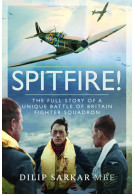The Dawn of Aviation (Hardback)
The Pivotal Role of Sussex People and Places in the Development of Flight
Imprint: Air World
Pages: 240
Illustrations: 40 black and white illustrations
ISBN: 9781526786340
Published: 2nd June 2021
(click here for international delivery rates)
Need a currency converter? Check XE.com for live rates
| Other formats available - Buy the Hardback and get the eBook for £1.99! | Price |
|---|---|
| The Dawn of Aviation eBook (22.9 MB) Add to Basket | £6.99 |
Shoreham airport, founded in 1910, is the oldest airport in the UK and the oldest purpose-built commercial airport in the world. Yet aviation began in Sussex far earlier, with balloonists making landfall at Kingsfold near Horsham in 1785.
These early activities attracted much attention, with some 30,000 people gathering at Black Rock in Brighton, as well as on the surrounding hills, to watch the first balloon ascent from the town in July 1821 – using coal gas from the recently opened gas works. That particular balloonist, Charles Green, later became immortalised by Charles Dickens in his Sketches By Boz.
The military were quick to appreciate the potential benefits of aerial observation and in 1880 balloons were deployed for the first time at the annual Volunteer Review at Brighton. Often wind conditions were not favourable for balloons, which prompted the army to consider employing kites and in June 1903 an international competition was held on the South Downs near Findon to see if kites could lift a man into the air. While this was found to be possible, it proved a terrifying experience for the unfortunate pilots.
Before powered flight became a reality, it was gliders which were the first heavier than air machines to take to the skies. In 1902 Mr Jose Weiss began launching unmanned gliders off a ramp at Houghton Hill near Amberley, which flew up to two miles. But soon the internal combustion engine made powered, controlled flight a reality and on 7 November 1908, Alec Ogilvie flew a Wright Brothers biplane along the coast at Camber.
By the time war broke out in 1914, the people of Sussex had seen the Brooklands to Brighton air race and the establishment of flying schools at Shoreham and Eastbourne. After the Armistice, aviation started becoming increasingly expensive and increasingly regulated. The halcyon days of swashbuckling amateurs taking to the skies in untested contraptions was drawing to a close.
"This book is an enjoyable and informative account of how flying originally came to the attractive corner of the UK in which The Aviation Historian has its business HQ."
Mick Oakey The Aviation Historian, Issue 39
The book should prove an interesting read for anyone with an interest in aviation in the period before the First World War.
Cross and Cockade
"This well-researched book evocatively conjures up the halcyon days of the swashbuckling amateurs who took to the skies in untested contraptions."
Sussex Life - December 2021
Dawn of Aviation by Josh Spoor is a very well written, informative and interesting book. It is a well-researched history of early aviation in Sussex, from ballooning in 1785, to the end of WW1. It describes pioneering flights, the development of airfields, aircraft construction and the personalities which drove these achievements forward. This book should appeal to anyone who has an interest in Sussex History.
Christopher Maughan
More from the sword: Forthcoming WWI related titles from Pen and Sword
Cher Ami from the International Plastic Modellers Society
About Roy Brooks
Having lived in Sussex for many years, the late ROY BROOKS developed a deep interest in the county’s aviation heritage. Over many years he delved deep into various archives and libraries to build up this remarkable insight into the early history of flight.
First Through The Clouds The Autobiography of a Box-Kite Pioneer (Hardback)
The early years of aviation were marked by flimsy, unreliable machines and daring adventurous young men. One of the pioneer aviators leading the way in Britain was F. Warren Merriam who, following Louis Blériot’s first flight across the Channel in 1809, joined the Bristol and Colonial Aeroplane Company through which he obtained a Royal Aero Club’s aviator’s certificate. Much of the flying training in those early days was a case of the blind leading the blind and, as Merriam wrote, ‘Flying was a dangerous business then. Aeroplanes were constantly breaking up in the air – let alone on…
By Frederick Warren MerriamClick here to buy both titles for £32.49
















